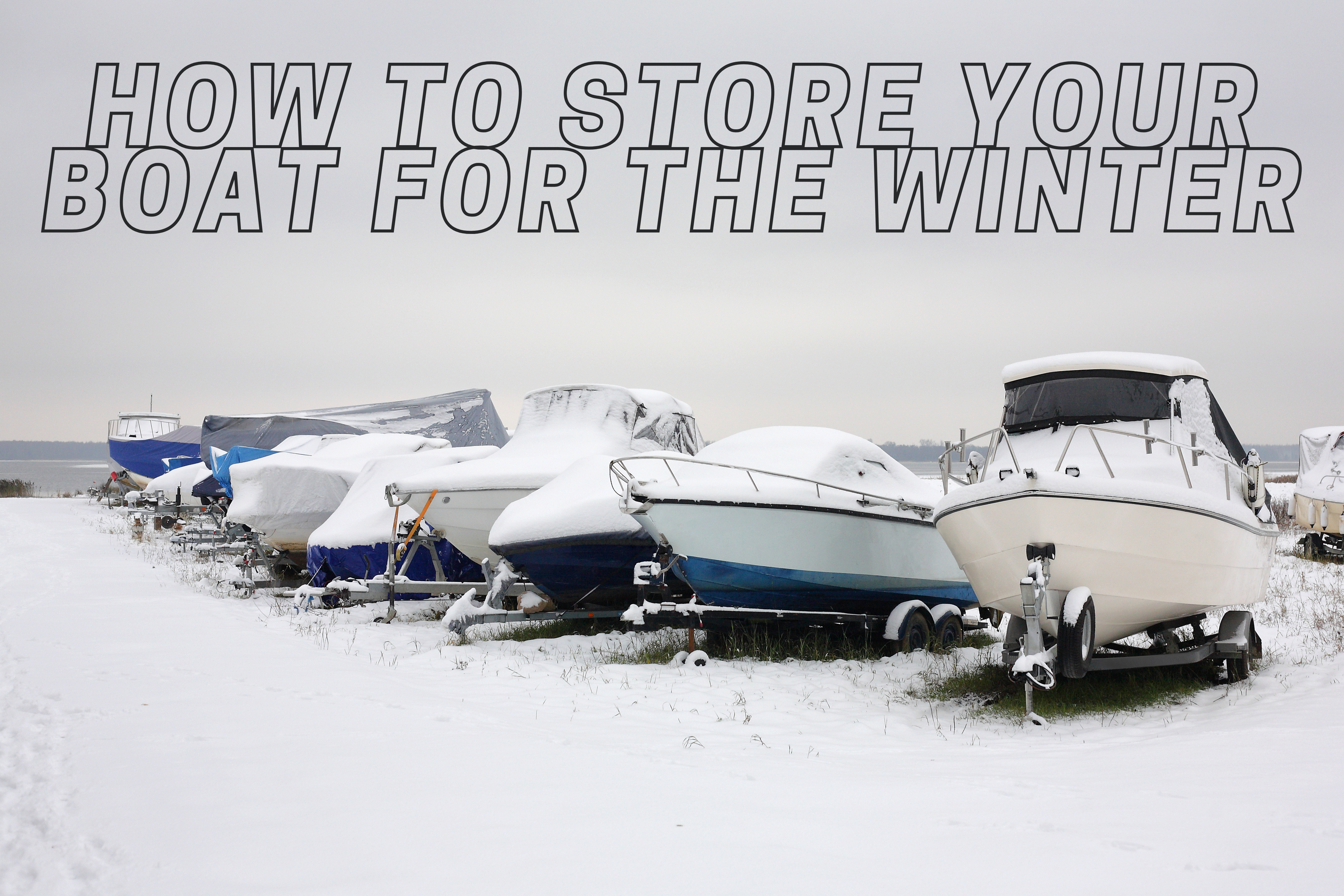
Storing your boat for the winter is not as easy as pulling it out of the lake and parking it in your lakefront home lawn for the season. The harsh winter conditions can contribute to the wear and tear to your boat and can be a pricey repair come spring time… There’s no need to worry because today’s blog post is all about how to store your boat for the winter!
Where to Store Your Boat- Most boaters will take their boats out of the water for the winter months and keep them outside, but another option is to store your boat indoors. Keeping your boat in the water all winter is not recommended unless you live in a very temperate location. This is because the boat is exposed to winter conditions, has a greater possibility of sinking if you aren’t monitoring it often, and is vulnerable to theft.
Backyard Boat Storage- Most boat owners choose to store their boats in the comfort of their own backyard. This saves money because you will not have to pay any storage fees. You will have to purchase a boat cover or get it professionally shrink-wrapped to prevent damage from elements, mold, and pests. There are a few cons to consider while storing it in your yard:

- Some neighbors do not allow storing boats in your own driveway because of the neighborhood agreement. If you do not follow this agreement, you could face penalties.
- Exposed to pests, molds, elements, theft, and vandalism.
- Requires having a pricey boat cover. Note also that a water-resistant tarp is not applicable for winter.
- Takes up yard space.
- Can be an eyesore
Dry Outdoor Boat Storage Facility- If you do not have enough room in your yard, then storing your boat in an outdoor storage facility is another good option. Each parking spot is typically shielded with a roof to provide some defense against the elements. Your boat stays near the dock and may not need transportation. Outdoor boat storage facilities are usually for smaller boats.
Dry Indoor Boat Storage Facility-

This is a pricier option when it comes to storing your boat, however it is the best option to protect your boat. Unfortunately, unless you keep your boat in a covered “dry stack” facility (sometimes called a “boatel,” where the boats sit on huge racks inside of a covered building), it can be very difficult to find indoor boat storage. If you have your own garage that can fit a boat then it is a no brainer to keep it inside at your own home!
How to Prepare Your Boat For Winter Storage-

- Run your boat once more: Pay attention to any issues that may need repair or replacement over the winter, especially with regards to the engine. Look for cracks in the hull, which will worsen if left unrepaired.
- Drain your boat: Remove the boat from the water and drain the bilge, water tanks, head, pipes and seacocks. Raise the bow to accelerate drainage if possible. If there is an electronic water heater, isolate it by removing the in and out lines and connecting the latter two together. Spray the bilge with a moisture-displacing lubricant. Add antifreeze into the bilge and water tanks to prevent freezing. (Do not drain the engine water intake until you winterize the engine.)
- Clean your boat: Thoroughly scrub the entirety of the boat with soap and water, from the hull to the interior. Remove any plant life and barnacles that have attached to the hull. Open any lockers, drawers, refrigerators and freezers and clean as well. Once the boat is scrubbed, leave enough time so that the boat is completely dry. Repair any blistering if you have a fiberglass boat. Afterwards, apply a coat of wax onto both the hull and the superstructure and polish evenly.
- Winterize the engine: Flush the engine (including the coolant system) with freshwater to remove salt, dirt and corrosion. Refill the coolant system with antifreeze. After briefly warming up the engine to loosen impurities, replace the oil and all filters while looking for any milky aspect to the old oil, since this indicates water intrusion. Apply fogging oil into the carburetor and spark plug holes. Remove and store away drive belts to avoid snapping due to tension. Finally, top off your engine with a full tank of gas mixed with stabilizer. Run the engine for about 15 minutes to make sure the additives reach fuel lines. (Be especially careful if your engine uses E-10 fuel, since it absorbs moisture 10 times more than typical gasoline.)
- Lubricate moving parts: Grease the steering system and control mechanisms. Lightly apply moisture-displacing lubricant on all moving metal parts such as hinges, latches and linkages. Detach the propeller, inspect for fishing line and seal damage, lubricate, and return to its position.
- Remove and charge the battery: Take out the battery and completely charge it. Clean the battery terminals and lightly coat them with grease. Do the same for the battery cable ends. Store the battery in a warm, dry place, noting that you will not place it back into the boat until the spring.
- Remove sensitive materials: Anything and everything that does not form part of the vessel should be removed and stored away, including life jackets, fire extinguishers and flares. If the interior of the boat is fitted with organic materials such as fabric and leather, remove these as well to prevent mildew deposits. Also remove all electronics, since these are easily damaged with extreme cold, and wrap exposed cable ends with electric tape. Store electronics in a warm, dry place as with the battery.
- Seal exhaust ports: If your boat employs exhaust ports, seal them with duct tape to prevent pests from entering and clogging these components.
- Cover and store your boat. Protect your boat with a cover that can withstand even the most brutal weather episodes. For harsher environments, consider shrink-wrapping your boat to provide additional protection. Remove snow buildup on a regular basis. If possible, store your boat under a canopy or in a garage. Use a dehumidifier if you will store the boat indoors. Mount your boat on supports with the bow tilted slightly upwards to encourage drainage. Avoid placing the boat on a trailer, since its tires and bearings can wear down over time.
- Check every few weeks: Repair any problem areas or components over the winter. Uncover and inspect your boat for new problems that might arise during storage. Check the battery to see if it is still charged. Remove any water that might have pooled in lower areas of the boat.
- Change the boat oil: Water that has gotten into the oil can corrode the engine. By changing the boat oil before storing you can avoid any long-term damage while stored.
- Freshen up to the Coolant System: Like the oil, draining and refreshing the coolant system with anti-freeze can prevent freezing and corrosion of the engine.
- Protect with Fogging Oil: This pro tip will go further to protect your engine during the winter months. Turn over your engine without starting it and spray the fogging oil where your manual instructs.
- Loosen or remove driving belts: This is a simple step that can save you stress and money. Remove or loosen drive belts before winter boat storage to prevent them from cracking under the stress.
- Grease the steering: Another preventative measure to get your boat ready for when you take it back out. Grease the steering and control mechanisms well so everything runs smoothly when it’s time to steer again.
- Maintain the battery: Prevention is the name of the game. Disconnecting the battery and charging it every once in a while throughout the winter can prevent the battery from draining and dying over the winter.
- Fill that tank: This may seem counterintuitive, but condensation can build up in an empty tank causing corrosion and even worse damage if it freezes. Add some gas and fuel stabilizer to make sure your tank is good to go during winter boat storage.
- Pay attention to the interior: Organic materials like canvas, leather, or other fabrics should be removed to avoid mold and mildew. And any electronics that could freeze should be removed to avoid damage.
- Wax on, Wax off: This step is especially important for storing your boat outside during the winter. Cleaning your boat inside and out and finishing with wax will help prevent rust on your boat’s body.
- Always use a cover: Finally, covering your boat will protect from elements like dirt, dust, and moisture.

Now that you know how to properly store your boat for the winter, you can kick back and relax at your lakefront home. You will be able to watch the snowflakes fall from your living room window, while curled up to an indoor fire in peace knowing your boat is safe and dry for the spring season.
Posted by Scott Freerksen “The Lake Guy”
